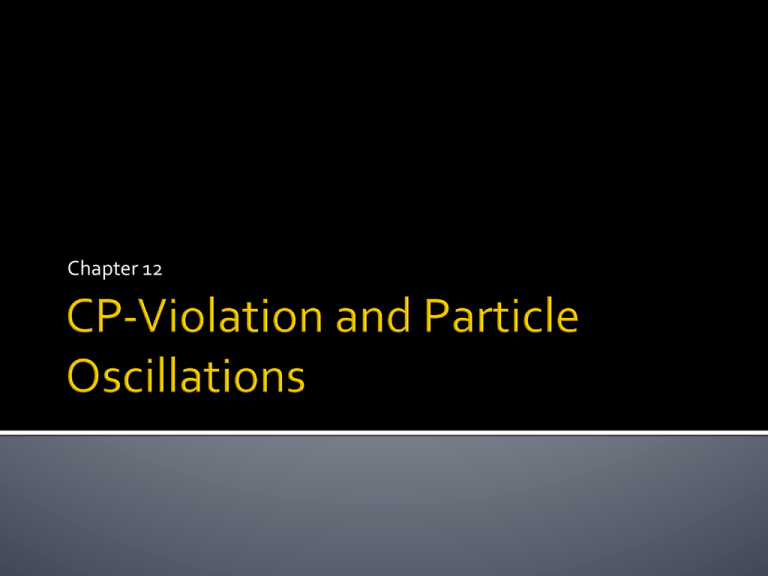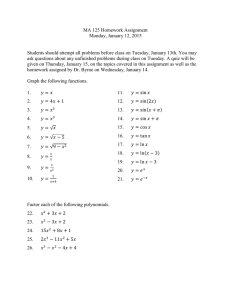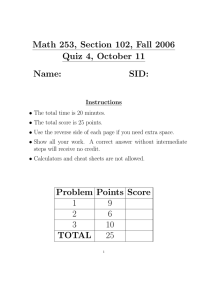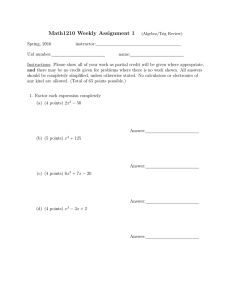Document 11412983
advertisement

Chapter 12 ¡
Refer to Chapter 8 § Kaon system § Oscillations and CKM mixing matrix § Neutrinos K10 =
1 "
$
2#
K 0 + K 0 '&
K 20 =
1 "
$
2#
K 0 − K 0 '&
%
K 0 and K 0
%
PK
¡
=−K
¡
; PK
0
=−K
0
K10 and K 20
are eigenstates of
CP :
CP K10 = + K10 ; CP K 20 = − K 20
K01 and K02 are like real particles to the weak interaction as are K0 and K0bar to the strong €
0
CP :
CP K 0 = K 0 ; CP K 0 = K 0
C K0 = − K 0 ; C K 0 = − K0
0
are not eigenstates of
CP π 0 π 0 = + π 0 π 0 ; CP π +π − =€
+ π +π −
CP π 0 π 0 π 0 = − π 0 π 0 π 0 ; CP π +π −π 0 = − π +π −π 0
K01 and K02 have different masses! K10 → ππ
K 20 → πππ
+& K S0 ≡ K10
mK − 2mπ ≈ 220MeV $&
% ⇒ Γ1 > Γ 2 → τ 1 < τ 2 ⇒ , 0
&- K L ≡ K 20
mK − 3mπ ≈ 90MeV &'
More in 12.2 π − + p →Λ 0 + K 0
τ 1 < τ 2 ⇒ K S0 ≡ K10 ; K L0 ≡ K 20
0
0
K +N →Λ +π
t = 0 ⇒ K 0 (0) =
At t ⇒
1
2
"
$$
# 1
e"#
$ $
%
oscillating time factor
1
Probability
2
27/05/15 "
$$
#
K10 (0) + K 20 (0)
a (t) K10 (0) + a2 (t) K 20 (0)
−i mα c 2t/!
aα (t) =
1
2
%
''
&
%
''
&
−Γα t/2!
−iMα t
e"
=
e
; M α = mα − iΓα / 2
#$
!##
#"###
$
particle decays
1
aα (t) = e−Γα t/! decreases exponentially with τ
2F. Ould-­‐Saada 2
K0bar – higher cross section than K0 α =1,2
−1
= Γα
4 − Γ +Γ t/2
P(K 0 → K 0 ) = 14 %&e−Γ1t + e−Γ2t + 2e ( 1 2 ) cos ( Δmc 2 t )'(
− Γ +Γ t/2
P(K 0 → K 0 ) = 14 %&e−Γ1t + e−Γ2t − 2e ( 1 2 ) cos ( Δmc 2 t )'(
Δm ≡ m1 − m2 ; Δm ⋅ τ S = 0.5 ⇒
¡
Intensity of the 2 components I(K 0 ) = f (distance from K 0source)
K 0 + p → π + + Λ 0 , π 0 Σ+
⇒ ΔmK = (3.483± 0.006) ×10 −12 MeV / c 2
ΔmK / mK = 0.7 ×10 −14
27/05/15
F. Ould-­‐Saada 5
¡ If CP were conserved, K01 decays into 3 pions, and K02 decays into 2 pions would be forbidden. § It was such a forbidden decay that was observed in 1964, showing that CP is not conserved! ¡
In the experiment, K0 beam was allowed to travel ~18m to ensure as few K01 present as possible § The products of the particle decays of K02 beam were then observed in detectors § Observation: 50 K02 à π+π- out of 23 000 decays! K + ε K ( ε ≈ 2 ×10 −3
1+ ε
*
)
iϕ
0
0$
1 ! 0
ε
=
ε
e
# K 2 − ε K1 &*
KL =
2
%
1+ ε "
+
0
S
K =
1
2
!
#
"
0
1
0$
2 &%
K L0 =
K S0 =
¡
(a) Indirect CP violation – by Mixing 1
1+ ε
2
1
1+ ε
2
2
⎛
⎜
⎝
K 20 + ε K10 ⎞⎟⎠
⎛
⎜
⎝
K10 − ε K 20 ⎞⎟⎠
2
(a) ε (1+ ε ) −1 ≈ ε
2
§ CP-­‐forbidden K01 component in K0L decays via CP-­‐allowed process K01 à ππ, giving contribution proportional to probability |ε|2 of €
finding K01 component in K0L § ΔS=2 à parameter ε
¡
(b) Direct CP violation § ΔS=1 – Penguin diagrams through g, γ, Z § à parameter ε’ << ε § CP-­‐allowed K02 component in K0L decays via CP-­‐
violating reaction K02 à ππ 27/05/15
7
η+− = (2.233± 0.010) ×10 −3; η00 = (2.222 ± 0.010) ×10 −3
¡
¡
ϕ +− = (43.52 ± 0.05)!
ϕ 00 = (43.50 ± 0.06)!
ε = (2.229 ± 0.010) ×10 −3
Re(ε '/ ε ) = (1.65 ± 0.26) ×10 −3
What was measured experimentally: Ratio R, Asymmetry A à extract CP violation parameters η+− = η+− e
η00 = η00 e
iϕ +−
iϕ 00
A(K L0 → π +π − )
=
= ε +ε '
0
+ −
A(K S → π π )
A(K L0 → π 0 π 0 )
=
= ε − 2ε '
0
0 0
A(K S → π π )
8
http://en.wikipedia.org/wiki/Cabibbo–Kobayashi–Maskawa_matrix ¡
CKM quark-­‐mixing matrix Vαi=probability (αài+W transition) Phase(eiδ) responsible for CP violation) 9 ¡
¡
Wolfenstein parameterisation § λ = s12 § Aλ2 = s23 § Aλ3(ρ − iη) = s13e−iδ Unitarity conditions § Equation of triangle The position of the apex is fixed by various experiments and provides a consistency check of the SM • If, for ex., β >0 à CP violation! • If triangle closed à3 generations! The position of the apex is fixed by
various experiments and provides
a consistency check of the SM.
- If, for ex., β >0 à CP violation!
- If triangle closed à3 generations!
¡
Various measurements to determine CKM parameters ¡
What is a neutral B-­‐meson? § Short lifetime à no beams of B mesons B 0 (5279.58) ≡ db ; B 0 ≡ bd
§ B-­‐factories Υ(4s): M=10.58GeV, Γ=20MeV B+ (5279.26) ≡ ub ; B − ≡ bu
B! = +1 B! = −1
e + e − → Υ (4 s ) → Bd0 Bd0 ; B + B −
J
27/05/15 PC
=1
−−
F. Ould-­‐Saada τ B ~ 1.5ps
Analog of K S0 , K L0 → BL0 , BH0
13 ¡
BaBar at PEP-­‐II, SLAC, US ¡
BELLE at KEK-­‐B, Japan AKπ
Γ( B 0 → K −π + ) − Γ( B 0 → K +π − )
≡
Γ( B 0 → K −π + ) + Γ( B 0 → K +π − )
AKπ = −0.095 ± 0.013
Other decays studied where CP violation measured Question: how do we know that a B0 (or anti-­‐B0) is produced? B 0 / B 0 → J / ΨK S
¡
Tag one B meson and study the other: B 0 → J / ΨK S → µ +µ −π +π −
§ Sign of K, µ B 0 → D 0 π −µ +ν µ ; D 0 → π − K +
§ Asymmetric collider βγ >> 1 ⇒ Δt = t2 − t1 =
z2 − z1
βγ c
¡ From other decay final states ¡
The Low Energy Anti-­‐
proton Ring (LEAR) § Very active in testing discrete symmetries ¡
¡
CPLEAR experiment proved in 1998 that time reversal symmetry, T, is not conserved in weak processes involving K mesons T-­‐invariance would require same probability for the inverse transformations K 0 →K 0
&
K 0 →K 0
Read next €slide and study the the principle od the measurement … ¡
CP-­‐violation in Standard Model § Kaon and B-­‐meson systems § not enough to explain the matter-­‐antimatter asymmetry in the Universe. ¡
Still unknown, sources of CP-­‐violation § Neutrino masses, oscillations and CP-­‐violation § Supersymmetry and or theories beyond SM ¡
In 1967, Sakharov, 1967 § CP-­‐violation is a necessary condition for baryogenesis ▪ à 13.6 The Big Bang and the Primordial Universe § leptogenesis in addition to baryogenesis? ¡
Sakharov: necessary to have § (a) an interaction that violates baryon number § (b) an interaction that violates charge conjugation C and CP § (c) a non-­‐equilibrium situation to seed the process ¡
Current situation § CP violation observed in K and B decays but not enough § Unknown sources of CP violations? Such in SUSY theories § Generation of non-­‐equilibrium? Maybe be within Baryon-­‐violating interactions of GUTs, or Leptogenesis? ¡
Matter-­‐Antimatter asymmetry remains a serious unsolved problem … kT > M X ⇒ X + X ↔ matter + radiation
kT << M X ⇒ no profuction norannihilation of X + X
27/05/15
⇒ X + X CP − violating decays
⇒F. more
matter than antimatter
Ould-­‐Saada 20
¡
In SM mν=0 § But if neutrino has non-­‐zero mass à oscillations may occur ¡
Beam of 1 type neutrino (νµ) develops components of other types (νe / ντ) § For this to happen à neutrino mixing ¡
Flavour states (νe , νµ , ντ) coupling to (e, µ, τ) don’t have definite masses but are linear combinations of (ν1 , ν2 , ν3) with definite masses m1, m2, m3, (eigenstates of mass) § να , α=1,2,3 are flavour eigenstates (of the weak interaction) § νi , i=1,2,3 are mass eigenstates (of the strong interaction, also eigenstates of Hamiltonian) ¡
3 neutrinos à 3 mixing angles à 3X3 matrix ¡
Simple case of 2 flavour states à one mixing angle θij à 2X2 matrix 26/05/15 F. Ould-­‐Saada 21 ¡
Simple case of 2 flavour states à mixing angle θij ν α = ν i cosθ ij + ν j sin θ ij
ν β = − ν i sin θ ij + ν j cosθ ij
#ν α & # cosθ ij
⇔ % ( = %
$ν β ' %$ −sin θ ij
sin θ ij &#ν i &
(% (
cosθ ij ($ν j '
'
!
Ei = p 2 + mi2
¡
να produced (through WI) at t=0 with momentum p, ¡
νi and νj have slightly different energies Ei and Ej (mi slightly different from mj, slightly different frequencies) ¡
¡
à mass eigenstates propagate independently à @ time t, original beam να “develops” component νβ whose intensity oscillates 26/05/15 F. Ould-­‐Saada 22 "$ ν α (0) = ν i (0) cosθ ij + ν j (0) sin θ ij
t = 0 :#
$% ν β (0) = − ν i (0) sin θ ij + ν j (0) cosθ ij = 0
Time evolution of mass eigenstates:
ν i, j (t) = e
−i
Ei, j t
!
ν i, j (o)
ν α (t) = ν i (t) cosθ ij + ν j (t) sin θ ij
= e
−i
Eit
!
−i
Eit
!
ν i (0) cosθ ij + e
−i
E jt
!
ν j (0) sin θ ij
−i
E jt
" ν α (0) cosθ ij − ν β (0) sin θ ij $ cosθ ij + e ! " ν α (0) sin θ ij + ν β (0) cosθ ij $sin θ ij
#
%
#
%
Et
" −i Eit
$
" −i Eit −i E jt $
−i j
2
2
= ν α (0) &e ! cos θ ij + e ! sin θ ij ' + ν β (0) &−e ! + e ! 'sin θ ij cosθ ij
&#
'%
&#
'%
= e
= A(t) ν α (0) + B(t) ν β (0)
Et
" −i Eit
$
−i j
2
2
!
!
ν β (0) = 0 ⇒ ν α (t) = ν α (0) &e cos θ ij + e
sin θ ij '
&#
'%
)+
" i (E j −Ei )t −i (E j −Ei )t $-+
2
4
4
2
2
ν α (t) ν α (t) = A(t) = ν α (0) ν α (0) *cos θ ij + sin θ ij + cos θ ij sin θ ij &e ! + e ! '.
&#
'%+/
+,
)
(E − Ei )t P(ν α → ν α ) = *1− sin 2θ ij ⋅ sin 2 j
. = 1− P(ν α → ν β )
2! /
,
(E − Ei )t
P(ν α → ν β ) = sin 2 2θ ij ⋅ sin 2 j
26/05/15 F. Ould-­‐S2!
aada 23 ν β (t) = − ν i (t) sin θ ij + ν j (t) cosθ ij
= −e
−i
Eit
!
−i
Eit
!
ν i (0) sin θ ij + e
−i
E jt
!
ν j (0) cosθ ij
−i
E jt
= −e "# ν α (0) cosθ ij − ν β (0) sin θ ij $%sin θ ij + e ! "# ν α (0) sin θ ij + ν β (0) cosθ ij $% cosθ ij
Et
" −i Eit −i E jt $
" −i Eit 2
$
−i j
2
!
!
!
!
= ν α (0) sin θ ij cosθ ij &−e
+ e ' + ν β (0) &e sin θ ij + e
cos θ ij '
&#
'%
&#
'%
" −i Eit −i E jt $
ν β (0) = 0 ⇒ ν β (t) = ν α (0) sin θ ij cosθ ij &−e ! + e ! '
&#
'%
" E − Ei ) t $
2
2 ( j
'
ν β (t) ν α (t) = P(ν α → ν β ) = sin (2θ ij )sin &
&# 2! '%
26/05/15 F. Ould-­‐Saada 24 ¡
At t=0 να produced with p (assume νβ=0, i.e. beam is pure να) ¡
At time t >0 § Mass eigenstates i and j propagate with energies Ei and Ej § να(t) not anymore pure να but a combination of να and νβ # ( E j − Ei ) t &
(
P(ν α → ν β ) = sin (2θ ij )sin %
%$ 2! ('
P(ν α → ν α ) = 1− P(ν α → ν β )
2
2
¡
P(νβ ) oscillates with time while P(να ) reduces by corresponding oscillating factor P(να ) =1-­‐ P(νβ ) ¡
Oscillation vanishes if mixing angle is zero OR mass eigen-­‐states are equal, in particular if m1=m2=0! § Possible enhancement if oscillations in matter 26/05/15 F. Ould-­‐Saada 25 mν very small
⇒ Ei, j >> mi, j c 2 (E ≈ pc;t ≈ L / c)
2 4
m
i, j c
2 2
2 4
Ei, j = p c + m i, j c ≈ 1+
2 pc
m 2j c 4 − mi2 c 4 Δmij2 c 4
⇒ E j − Ei ≈
=
2 pc
2 pc
#L&
P(ν α → ν β ) ≈ sin (2θ ij )sin % (
$ L0 '
2
2
4E !c
with L0 =
Δmij2 c 4
2#
2&
#
&
Δm
eV
ij
$
'
P(ν α → ν β ) ≈ sin 2 (2θ ij )sin 2 %1.27
L [ km ](
E [GeV ]
%$
('
Oscillations detected experimentally and non-­‐zero neutrino mass established! ¡
26/05/15 F. Ould-­‐Saada 26 § Atmospheric neutrinos stem from decays of charged pions (and kaons), which are produced through interactions between primary cosmic rays and the atmosphere p + N → π,K,...
π − → µ−νµ
µ − → e − νe ν µ
π + → µ+νµ
µ + → e + νe ν µ
$
⎛ !NN
ν µν µ⎞
R R= =⎜ ## ⎟ &&~~22
⎜ "NN
⎟
⎝ ν eν ⎠e %
26/05/15 F. Ould-­‐Saada 27 νl + N → l + N '
l = e, µ
50’000 tons ultra pure
Water: h=40m, Ø=40m
Depth: 2700 mwe
13’000 photomultipliers
à Cerenkov radiation
⎛ N ν µ
⎜
⎜ N ν
⎝ e
⎞
⎟
~2
⎟
⎠expected
R ( ν µ / νe ) ≡
26/05/15 F. Ould-­‐Saada (µ / e )measured
(µ / e )simulated
<1
28 L[km]
⎡
⎤
P(ν µ → ντ ) ≈ sin 2 ( 2θij ) sin 2 ⎢1.27
Δmij2 [eV 2 ] ⎥
E[GeV]
⎣
⎦
Δmij226/05/15 ≡ mi2 − m2j
F. Ould-­‐Saada 2
⎛ eV ⎞
2
1.9 × 10 −3 ≤ Δm32
≤ 3.0 × 10 −3 ⎜ 2 ⎟
⎝ c ⎠
2
Δm32
≈ 2.1 × 10 −3 ; sin 2 ( 2θ32 ) ≥ 0.9
29 The Homestake solar neutrino experiment, R. ¡
§ 1st observation of Solar Neutrino Deficit § Detector: 615 tons C2Cl4 § Appearance of atoms of radioactive 37Ar νe + 37Cl à e- + 37Ar, Ethreshold=0.814 MeV
Experiment observed an event rate of: 2.56±.23 SNU ¡
§ 1 SNU = 10-­‐36 interactions / target atom s Standard Solar Model flux prediction: 7.7+1.2-­‐1.0 SNU Factor of three discrepancy ¡
¡
§ solar neutrino problem – SNP § inspired so much of modern neutrino physics. ¡
SNP confirmed by various experiments 26/05/15 F. Ould-­‐Saada 30 p + p→2 H + e + + ν e + 0.42MeV
p + e− + p → 2 H + ν e +1.44MeV
“pep” 0.25%
“pp” 99.75%
2
H + p→3He + γ + 5.49 MeV
86%
3
14%
He+3He → α + 2 p + 12.86 MeV
3
He + α →7Be + γ + 1.59 MeV
“7Be”
99.89%
7
Be + e − →7 Li + γ + ν e + 0.8617 MeV
7
“hep” 2.4*10-5
Li + p → α + α + 17.35MeV
F. Ould-­‐Saada He + p → α + e + + ν e
0.11%
7
Be + p→8B + γ + 0.14 MeV
“8B” 0.11%
8
B→8Be + e + + ν e + 14.6 MeV
8
26/05/15 3
Be → α + α + 3MeV
31 ν
Experiment process
E Threshold
Sun process
E mea n
νe + 37Cl →37Ar + e −
0.81 MeV
8
7 MeV
B→8Be + e − + νe
e − + 7Be→7Li + νe
0.862 MeV
νe + 71Ga →71Ge + e −
0.26 MeV
p + p → d + e + + νe
0.42 MeV
νx + e− → νx + e−
5MeV
8
7 MeV
νe + d → e − + p + p
5MeV
8
ν x + d → ν x + p + n F. Ould-­‐
5MeV
26/05/15 Saada 8
B→8Be + e − + νe
B→8Be + e − + νe
7 MeV
B→8Be + e − + νe
7 MeV
32 26/05/15 F. Ould-­‐Saada 33 ¡
SNO (Sudbury Neutrino Observatory) §
embedded 2070 m in the Creighton mine at Sudbury, Ontario, Canada ¡
Threshold ~ 5 MeV. Muon flux 200x smaller than SK. ¡
1000 tons D2O + 7000 tons H2O, 9600 photomultipliers. ¡
SNO’s advantage: all neutrino favours can be measured ¡
SNP definitely solved through neutrino oscillations 26/05/15 F. Ould-­‐Saada 34 2
¡
¡
¡
Solar neutrino experiments + KamLand (long baseline reactor experiment) Atmospheric neutrino experiment supported by long baseline accelerator experiments Nuclear reactor ⎛ eV ⎞
2
7.6 × 10 −5 ≤ Δm21
≤ 8.6 × 10 −5 ⎜ 2 ⎟
⎝ c ⎠
0.32 ≤ tan 2 ( 2θ12 ) ≤ 0.48 ; 29° ≤ θ12 ≤ 35°
2
⎛ eV ⎞
2
1.9 × 10 −3 ≤ Δm32
≤ 3.0 × 10 −3 ⎜ 2 ⎟
⎝ c ⎠
2
Δm32
≈ 2.1 × 10 −3 ; sin 2 ( 2θ32 ) ≥ 0.9
sin 2 (2θ13 ) ≈ 0.10
2
Δm32
,
2
Δm21
,
θ12 , θ13 , θ32
26/05/15 F. Ould-­‐Saada 35 What is the right neutrino mass pattern? Neutrino masses § Oscillation data à mixing between all 3 neutrino mass states § Solar neutrino oscillation in matter à sign of Δm212
§ Sign of Δm
322 not determined à 2 solutions for mass hierarchy! 26/05/15 F. Ould-­‐Saada 36 ¡
Direct mass measurement § But neutrino electron = 0 ≤ mνe <
2eV
−6
≈
4
×
10
me
2
c
superposition of 3 mass eigenstates 2
¡
mi2 > m 2j ⇒ ( mi − m j ) < mi2 − m 2j
However ⎛ eV ⎞
7.6 × 10 ≤ Δm ≤ 8.6 × 10 ⎜ 2 ⎟
⎝ c ⎠
−5
2
21
2
−5
⎛ eV ⎞
2
1.9 × 10 −3 ≤ Δm32
≤ 3.0 × 10 −3 ⎜ 2 ⎟
⎝ c ⎠
¡
m3 − m2 ≤ 5 ×10 −2 eV / c 2
2
Bounds from cosmology § Analysis of large scale structures of Universe à § (indirect limit) 26/05/15 m2 − m1 ≤ 10 −2 eV / c 2
⇒ mi ≤ 2eV / c 2 << ml
3
∑m
νl
≤ 1eV / c 2
i=1
F. Ould-­‐Saada 37 In a 3-ν framework
⎛ ν e ⎞ ⎛ U e1 U e 2 U e3 ⎞ ⎛ν 1 ⎞
⎜ ⎟ ⎜
⎟ ⎜ ⎟
⎜ν µ ⎟ = ⎜ U µ1 U µ 2 U µ 3 ⎟ ⎜ν 2 ⎟
⎜ν ⎟ ⎜ U
⎟ ⎜ν ⎟
U
U
τ2
τ 3 ⎠ ⎝ 3 ⎠
⎝ τ ⎠ ⎝ τ 1
0
0 ⎞ ⎛ c13
0
⎛ 1
⎜
⎟ ⎜
U = ⎜ 0 c23 s 23 ⎟ ⎜ 0 e−iδ
⎜ 0 − s
⎟ ⎜ − s
c
0
23
23 ⎠ ⎝
13
⎝
θ23 ~ 45°
Atmospheric
Accelerator
26/05/15 s13 ⎞⎛ c12
⎟ ⎜
0 ⎟ ⎜ − s12
c13 ⎟⎠ ⎜⎝ 0
θ13 = ?
Reactor
Accelerator
F. Ould-­‐Saada s12
c12
0
θ12 ~ 34°
Solar
Reactor
0 ⎞ ⎛ eiρ
⎟ ⎜
0 ⎟ ⎜ 0
1 ⎟⎠ ⎜⎝ 0
0
eiσ
0
0 ⎞
⎟
0 ⎟
1 ⎟⎠
0νββ
38 ¡ Matter-­‐Antimatter asymmetry, neutrino mass and nature remain serious unsolved mysteries … ¡ … as are several other enigmas … ¡ … waiting for you … 28/05/15
F. Ould-­‐Saada 39




